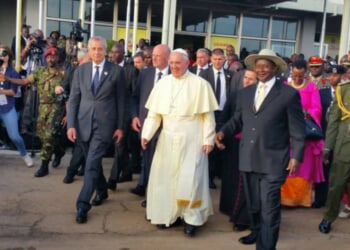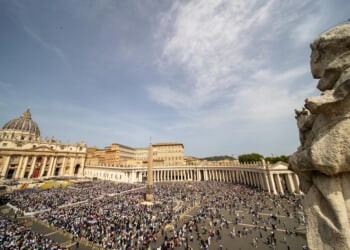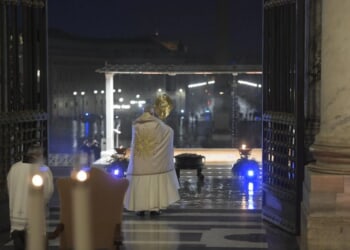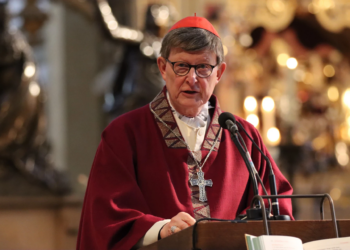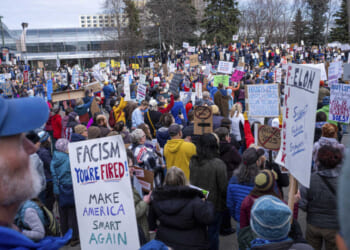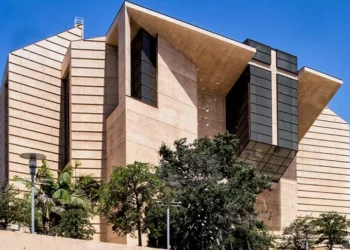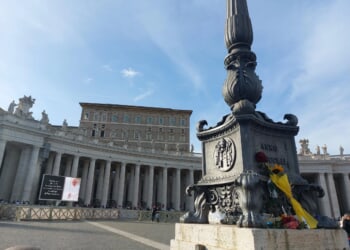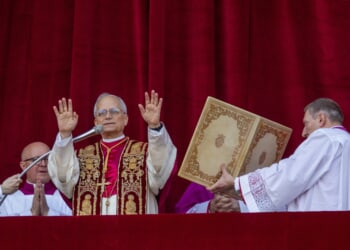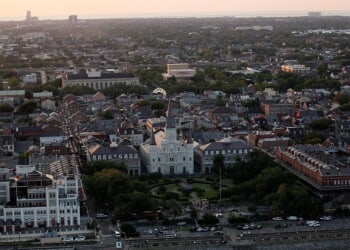Rome, Italy, May 25, 2025 /
13:17 pm
Pope Leo XIV delivered his first homily as bishop of Rome at the Basilica of St. John Lateran, where he took possession of his cathedra (throne) on Sunday.
The pontiff said ecclesial communion is built “on our knees, through prayer and constant commitment to conversion” as he invoked the example of the first Christians, who faced the challenges of proclaiming the Gospel to a pagan world.
Reflecting on the episode from the Acts of the Apostles, where the early Christians debated about whether Gentile converts had to follow the law of Moses, Pope Leo XIV emphasized that “this was no easy matter; it called for much patience and mutual listening.”
He referenced the Council of Jerusalem, the first great council of the early Church, in which “a dialogue was opened” that led to a fitting decision: “Recognizing the difficulties of the new converts, they agreed not to impose excessive burdens on them but rather to insist only on what was essential.”
“In this way,” he added, “what might have seemed a problem became for everyone an opportunity for reflection and growth.”
“The most important part of the entire event,” he emphasized, “was listening to God’s voice, which made everything else possible.” This, he said, is how communion is truly built.
“For only in this way can each of us hear within the voice of the Spirit crying out ‘Abba! Father!’ and then, as a result, listen to and understand others as our brothers and sisters,” he continued.
The day’s Gospel reading reinforced this point. “It assures us that we are not alone in making our decisions in life. The Spirit sustains us and shows us the way to follow, ‘teaching’ us and ‘reminding’ us of all that Jesus said,” the pope affirmed.
“The more we let ourselves be convinced and transformed by the Gospel — allowing the power of the Spirit to purify our heart, to make our words straightforward, our desires honest and clear, and our actions generous — the more capable we are of proclaiming its message,” he added.
For this reason, he stressed that, throughout the process — as in the Council of Jerusalem — “the most important listening” is that of listening to God’s voice.
Addressing the cardinals of the Roman Curia, bishops, priests, deacons, religious, and laity of the Diocese of Rome, the pope continued: “I would like to express my firm desire to contribute to this great ongoing process by listening to everyone as much as possible, in order to learn, understand, and decide things together, as St. Augustine would say, ‘as a Christian with you and a bishop for you.’”
“I would also ask you to support me in prayer and charity,” he said, “mindful of the words of St. Leo the Great: ‘All the good we do in the exercise of our ministry is the work of Christ and not our own, for we can do nothing without him. Yet we glory in him, from whom all the effectiveness of our work is derived.’”
He recalled Blessed John Paul I, who, “with the joyful and serene face that had already earned him the nickname of ‘the Smiling Pope,’” took possession of the chair of the bishop of Rome in September 1978.
“I too express my affection for you and my desire to share with you, on our journey together, our joys and sorrows, our struggles and hopes. I too offer you ‘the little I have and am,’ entrusting it to the intercession of Sts. Peter and Paul and of all those other brothers and sisters of ours whose holiness has illuminated the history of this Church and the streets of this city,” he said.
The pope also affirmed the legacy of the Church of Rome as “heir to a great history, grounded in the witness of Peter, Paul, and countless martyrs,” and emphasized her unique mission: “to be ‘Omnium Ecclesiarum Mater,’ mother of all the Churches.”
The Basilica of St. John Lateran bears the honorary title of “mother and head of all the Churches in the city of Rome and the whole world.” Taking this as a metaphor, the pope recalled that his predecessor Pope Francis invited the faithful to reflect on the “maternal dimension” of the Church and on its defining characteristics.
(Story continues below)
Subscribe to our daily newsletter
Among these are “tenderness, self-sacrifice, and the capacity to listen,” traits that, the pope said, “enable her not only to assist others but often to anticipate their needs and expectations before they are even expressed.”
“We hope that those qualities will be increasingly present in the people of God everywhere, including here, in our great diocesan family: in the faithful, in pastors, and, first of all, in myself,” he added.
He praised the “challenging process of listening that the Diocese of Rome has undertaken in these years,” structured around various levels of listening — “to the world around us to respond to its challenges and listening within our communities to understand needs and to propose sage and prophetic initiatives of evangelization and charity.”
Although he acknowledged that this is “a challenging, ongoing journey meant to embrace a very rich and complex reality,” he said it is worthy of the Church’s history — one that has often shown its ability to “think big,” giving itself fully to courageous projects and even taking risks in the face of new and complex scenarios.
He specifically highlighted the extensive work being done by the entire Diocese of Rome for the jubilee year, welcoming and caring for pilgrims and launching many other initiatives.
“These have made the city of Rome appear to visitors, some of whom have traveled from far away, as a wide, open and welcoming home, and above all as a place of deep faith,” he concluded.
A gesture of communion
During the liturgy, the Holy Father received the pledge of fidelity from a representative group of the people of God in Rome in the Rite of Obedience. This symbolic expression of communion was not led by cardinals or members of the Curia but by people from the diocese: an auxiliary bishop, a canon, a parish priest, a parochial vicar, a deacon, religious men and women, a family, an educator, a catechist, and two young people.
Among the participants were Cardinal Vicar Baldassare Reina, Auxiliary Bishop Renato Tarantelli, and other clergy and laypeople, including Brother Luis Martín Rodríguez, Sister Rebecca Nazzaro, and two young people, Mirko Venditti and Teresa Martellotta. Each of them represented a vital dimension of the Roman Church now recognizing its new bishop as their shepherd.
Before arriving at the basilica — the first great Christian building erected in Rome after Emperor Constantine legalized religious freedom in A.D. 313 — the pope met with the mayor of Rome, Roberto Gualtieri. At the foot of the staircase of the Capitoline Hill, where the main entrance to the historic Palazzo Senatorio (city hall) stands, the mayor paid homage to him as the new bishop of Rome.




